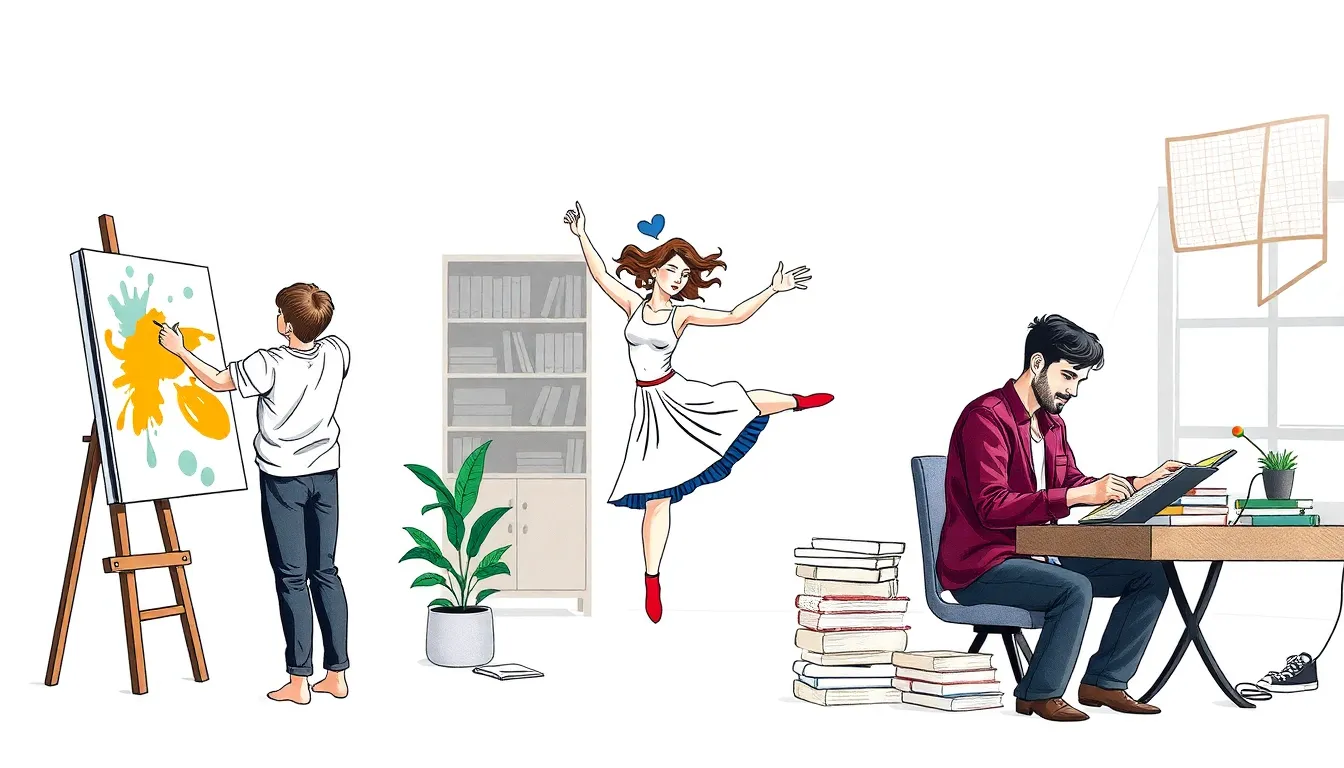Table of Contents
ToggleArtistic expression isn’t just for the elite or the eccentric; it’s a universal language everyone can speak—even if that means doodling stick figures in a meeting. From the vibrant strokes of a paintbrush to the rhythmic beats of a drum, art gives voice to emotions and ideas that often go unspoken. It’s the ultimate stress-reliever, a way to unleash creativity, and let’s face it, a fantastic excuse to avoid doing the dishes.
In a world that sometimes feels overly serious, artistic expression invites people to embrace their quirks and showcase their individuality. Whether it’s through painting, music, dance, or even interpretive mime (though maybe skip that one at family gatherings), the possibilities are endless. So grab that paintbrush, strum that guitar, or just let loose with some finger paints. It’s time to discover the joy of creating and connect with the world in a way that’s uniquely yours.
Understanding Artistic Expression
Artistic expression allows individuals to convey their emotions and thoughts, serving as a universal language that transcends barriers. Various forms of art encourage creativity and personal reflection.
Definition and Significance
Artistic expression refers to the myriad ways people communicate their inner experiences and beliefs through creative mediums. It holds immense significance as it fosters individual identity, emotional release, and social connection. Art provides a safe space for exploration and experimentation, allowing artists and audiences to engage with complex themes. Engaging in artistic avenues often cultivates empathy, encouraging deeper understanding among diverse communities. Studies indicate that participation in the arts positively impacts mental health, enhancing well-being and reducing stress.
Historical Context
Throughout history, artistic expression has reflected cultural values and societal shifts. Ancient civilizations utilized art to document history and spiritual beliefs, while the Renaissance emphasized humanism and individual creativity. Significant movements, such as Romanticism and Modernism, challenged conventional norms and explored new forms. In the 20th century, art became a powerful tool for political and social commentary. Current trends continue to break boundaries, with digital art and street art gaining mainstream recognition. These diverse historical contexts illustrate how artistic expression evolves to address contemporary issues, remaining relevant across generations.
Forms of Artistic Expression

Artistic expression manifests in diverse forms, each allowing unique ways to communicate feelings and ideas.
Visual Arts
Visual arts encompass multiple mediums like painting, sculpture, and photography. These formats enable artists to capture their interpretations of reality. Color palettes convey moods while shapes and textures invite visual exploration. For example, impressionist paintings evoke emotion through brushstroke techniques. Photography captures moments in time, providing a lens to view the world from various angles. Artists often use visual arts for personal expression, societal commentary, or cultural representation, reflecting the intricacies of human experience.
Performing Arts
Performing arts include disciplines like theater, dance, and music that emphasize live presentation. These forms engage audiences by bringing stories and emotions to life. In theater, actors immerse themselves in characters, often eliciting empathy and understanding from viewers. Dance showcases movement as a form of expression, allowing the body to communicate in rhythm and grace. Musicians combine melody and lyrics, creating an auditory experience that resonates with audiences. Each performance acts as a collaboration between artists and viewers, fostering connection and shared experiences.
Literary Arts
Literary arts feature storytelling through written works such as poetry, novels, and essays. Authors express their thoughts, emotions, and observations, inviting readers to explore different perspectives. Poetry distills feelings into concise language, often using imagery and rhythm to evoke responses. Fictional narratives enable imagination, presenting characters and plots that mirror real-life complexities. Essays provide insights and arguments, encouraging critical thinking and dialogue. Through literary arts, writers foster empathy, provoke thought, and connect people across diverse backgrounds.
The Role of Artistic Expression in Society
Artistic expression plays a vital role in shaping society. It reflects cultural values and societal changes, serving as a mirror to the collective consciousness.
Cultural Reflection
Art captures the essence of a culture, showcasing its beliefs and traditions. It documents historical moments through various forms, from cave paintings to contemporary installations. Each piece conveys unique stories, fostering a sense of identity within communities. Artists often draw inspiration from their surroundings, highlighting local issues and experiences. This ongoing dialogue between art and culture encourages understanding and appreciation of differing perspectives. Cultural celebration occurs through festivals, exhibitions, and performances, enriching societal dynamics.
Social Change and Activism
Art serves as a powerful vehicle for social change and activism. Through visual arts, music, and performance, artists address pressing societal issues. Various movements have emerged, using art to promote justice and equality. For example, protest art resonates deeply, igniting conversations about human rights and environmental concerns. Artists often collaborate with communities to amplify marginalized voices, transforming public spaces into platforms for awareness. Activist art fosters empathy, encouraging audiences to engage with critical topics. This dynamic intersection of art and activism shapes perceptions and drives societal progress.
Personal Benefits of Artistic Expression
Artistic expression enhances personal well-being and offers numerous benefits. Engaging in various art forms promotes a richer emotional and cognitive life.
Emotional Release
Art serves as a powerful outlet for emotions. Many find painting, drawing, or playing music helps them process feelings like sadness or joy. Participants often experience relief from stress and anxiety when expressing themselves artistically. Creative activities provide a safe space for vulnerability. Art encourages individuals to confront their emotions, resulting in greater self-awareness. Connecting with one’s feelings fosters emotional healing. Expressive art techniques, such as journaling or drama, also facilitate personal growth and clarity. People often discover insights about themselves they hadn’t recognized before. Increased emotional understanding leads to healthier relationships and emotional resilience.
Cognitive Development
Participating in artistic activities stimulates cognitive functions. Individuals involved in music or visual arts experience enhanced problem-solving skills and creativity. Engaging in art encourages critical thinking and improves memory retention. Musicians often develop greater discipline, which translates into other areas of life. Visual arts require attention to detail, aiding in visual-spatial skills. Research shows children exposed to art display better academic performance. Adults practicing art frequently report sharper focus and innovative thinking. Exploring different artistic mediums promotes adaptability and open-mindedness. Regular interaction with art cultivates a lifelong love of learning and exploration.
Artistic expression is a vital part of the human experience. It transcends barriers and fosters connections among individuals and communities. By engaging with various art forms, people can explore their emotions and share their unique perspectives with the world.
The transformative power of art not only enriches personal lives but also shapes societal values. As individuals embrace their creativity, they contribute to a collective narrative that promotes empathy and understanding. Whether through visual arts, performing arts, or literary arts, everyone has the potential to make their voice heard.
Ultimately, artistic expression serves as a reminder of the beauty in diversity and the importance of self-discovery. It invites everyone to celebrate their individuality and connect with others, creating a more vibrant and inclusive world.




